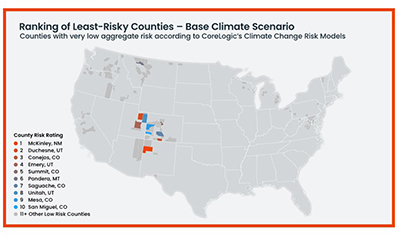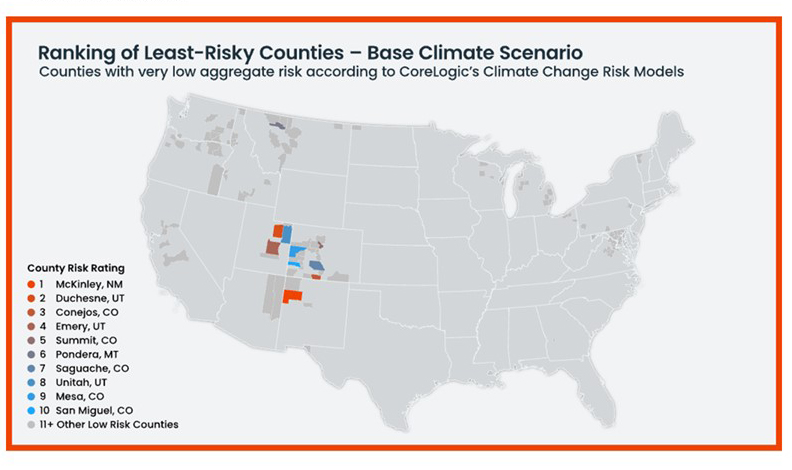
‘Four Corners’ States Rank Highest in ‘Safest Places to Live’ Study

CoreLogic, Irvine, Calif., said counties in the ‘Four Corners’ states—Arizona, Colorado, New Mexico and Utah—rank highest in its annual ‘Safest Place to Live’ study, which details the least risky places to live in the U.S. from a natural hazard perspective.
While severe convective storms and flooding pose risk to most homes in the U.S., McKinley County, New Mex., emerged as the least risky county to live due to its lack of hurricane and earthquake risk. Additionally, five counties in Colorado rank in the top 10 for lowest-risk areas for natural catastrophes.

CoreLogic analyzed wildfire, inland flood, severe convective storm, winter storm, earthquake and hurricane perils and applied its analytics capabilities to its extensive property datasets to provide deep insights into natural hazards, climate risks and the resulting impacts on the property landscape.
As a result, the top 10 counties safest from natural disaster are:
1. McKinley, New Mexico
2. Duchesne, Utah
3. Conejos, Colorado
4. Emery, Utah
5. Summit, Colorado
6. Pondera, Montana
7. Saguache, Colorado
8. Unitah, Utah
9. Mesa, Colorado
10. San Miguel, Colorado
In examining a progressively worsening climate, the safest counties in 2050 become:
1. McKinley, New Mexico
2. Conejos, Colorado
3. Summit, Colorado
4. Duchesne, Utah
5. Saguache, Colorado
6. Spokane, Washington
7. Emery, Utah
8. Eagle, Colorado
9. San Juan, Colorado
10. Chaffee, Colorado
This analysis considers the impactful environmental risks to 154 million properties across the U.S. and is built on CoreLogic’s Climate Risk Analytics: Composite Risk Score platform to identify counties that are currently at low risk and stress-tests natural disaster risks over the next 30 years across various future climate scenarios.
The climate scenarios include a base climate where conditions do not change and a progressively worsening climate noted as “Scenario 8.5,” that describe several potential future scenarios. The RCP 8.5 climate change results discussed here represent a projection of climate related risks to residential properties assuming that C02 emissions continue to rise throughout the 21st century.
